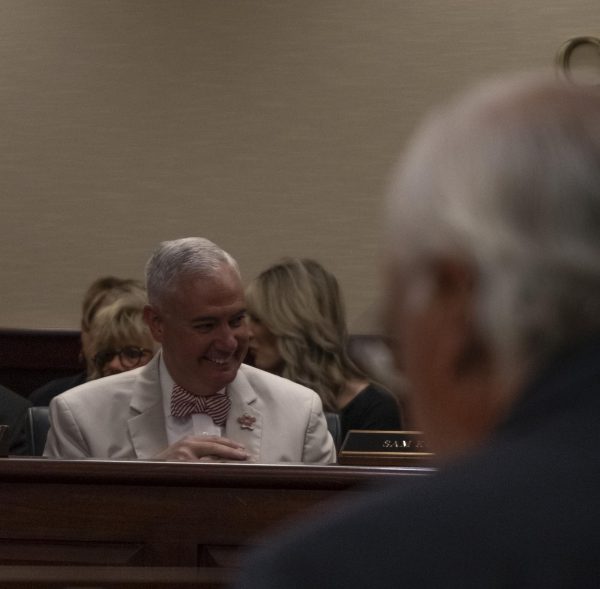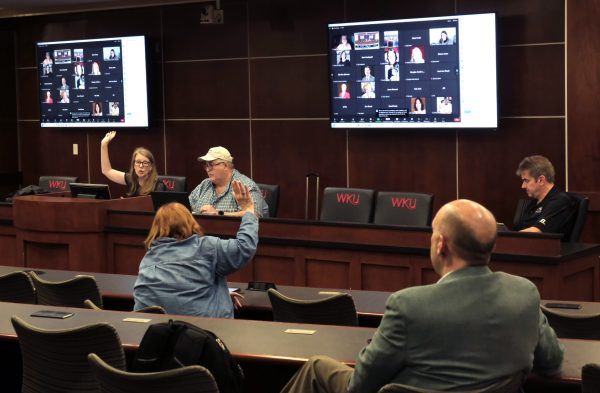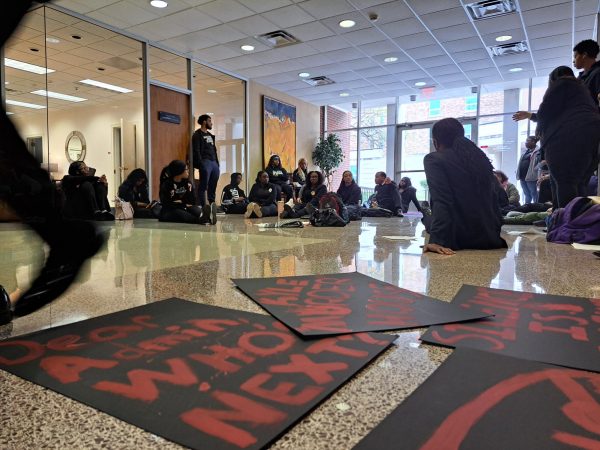The impact of Title IX on intercollegiate athletics
Katy Tinius (far right), Shelley Fredlake (second from right) and two other team mates talk on the WKU tennis courts, previously located where the current WKU baseball indoor facility is. At the time, the women’s team did not have uniforms provided by the school.
March 21, 2023
When Katy Tinius became WKU’s first female athlete on scholarship following the ratification of Title IX, which transformed the athletic and academic landscape for women, her team lacked basic resources.
“The whole time we were there, we had no uniforms,” Tinius said, who played on the WKU tennis team from 1975-1979. “We would all go in whatever we had, whatever we brought from home is what we wore and of course you see the men with all the uniforms.”
Over time, female athletes were given uniforms and access to equipment. Tinius and her teammates were the first of generations of female athletes to play at WKU.
Half a century can have a large impact.
Since Title IX was signed into law by President Richard Nixon in 1972, both academics and athletics have been turned inside out. Ultimately, Title IX bans discrimination based on sex in any federally funded educational program, which paved the way for the rapidly growing world of women’s athletics.
Title IX, primarily written and supported by former Hawaii Representative Patsy T. Mink, intended to open opportunities for women in teaching positions and academic programs. Prior to the enactment of Title IX, 57% of college students in four year institutions were male and 43% were female, according to National Affairs. By 2020, the numbers seemingly flipped as women made up 58% of all undergraduate students and men made up 42% according to the National Center for Education Statistics.
Leveling the playing field for all athletes
The amendment quickly transitioned to the athletic world. Not only did Title IX ensure women’s participation in sports on the collegiate level and lower, but it forced schools to provide equal funding.
Before Title IX, according to the Women’s Equity Resource Center, women’s collegiate athletics received on average only 2% of college athletics budgets and athletic scholarships for women did not exist.
According to a report by the Women’s Sports Foundation, in 1972, only 15% of college athletes were women at 30,000, as opposed to 170,000 men. 50 years following the enactment of Title IX, women made up 44% of all NCAA athletes.
For Tinius, the law opened up new opportunities.
“At the beginning I was just so excited, A, I got to go to college, B, I loved the girls on the team and we were all from different places, different backgrounds… So that part was so much fun and I never really thought about the people to come,” Tinius said. “… But what the administration and the coaches were going through, you’re thinking, wow, this is going to pay off and hopefully continue and continue.”
Title IX not only provides opportunities academically and athletically, but it also protects both women and men against sexual harassment and assault. Schools are required to take action if they have any knowledge of sexual harassment or violence at any level taking place within a team or academics.
Title IX’s impact on WKU
Despite Title IX’s efforts to level the playing field, there are also some downfalls for athletes who fall victim to school budget cuts and Title IX equity rules.
Under the amendment, schools are required to balance the budgets between men’s and women’s athletics. Some schools resort to cutting men’s athletic teams before women’s in order to accommodate for bigger team budgets such as football or basketball.
In 2008, WKU students voted to move Hilltopper football to Division 1A, which opened 22 more athletic scholarships for football players and allowed the team to be more competitive.
In order to enable this move, Camden Wood Selig, WKU athletic director from 1999-2010, and other administrative members made difficult decisions regarding WKU’s financial situation and in order to remain in good standing with Title IX.
“We didn’t want to cut men’s opportunities, but the 22 additional scholarships playing at the 1A level versus the 1AA level is millions of dollars more per year[…] so we were hard pressed to pay for the move,” Selig said.
WKU added softball to the mix in 2000. Despite WKU’s efforts to balance the budget elsewhere, the school still fell short, both financially and with meeting Title IX requirements because of the amount spent on football. Ultimately, the decision to cut men’s soccer saved the school around a million dollars and helped meet Title IX regulations. Six years later, in 2014, men’s tennis was also eliminated for similar reasons.
“I mean, you’re losing members of your family,” Selig said. “You’re disconnecting yourself with potentially generations of student athletes and relationships. It’s one of the worst experiences to go through in college athletics.”
It wasn’t a popular decision, Selig said.
“It was a last resort,” he said. “It wasn’t at the top of our list either as we were looking to make ways to balance our budget and stay competitive across all sports. You can’t be all things to all people.”
Although there were other factors that contributed to the removal of WKU men’s soccer, Title IX does not force universities to end men’s athletic teams. Instead, the amendment holds schools accountable for their decisions.
Author Kelsey Evrick is a former Division I goalkeeper for Xavier University from 1990-1993. Evrick’s book “The Keeper” depicts how Title IX shaped Evrick’s life as an athlete and changed equality in athletics.
“I don’t like when it is framed as ‘oh this women’s team came in and forced out a men’s team. Universities are free to make their own decisions about how they create equal opportunities,” Evrick said.
Despite the prevalence of Title IX in the academic and athletic world, there appears to be a lack of awareness of the amendment that protects the rights of over half of college undergraduates.
According to a poll taken in 2022 by the Washington Post – University of Maryland, upon the 50 year anniversary of Title IX, roughly 67% of Americans have little to no understanding of what the amendment is.
“So I think we still have a long way to go, but I think some good steps have been made,” said Evrick. “I think people’s awareness of the 50th anniversary of Title IX helps when there are more discussions about it and people are reflecting on it.”
Title IX continues to protect the rights of women to equal education and athletics decades after its legalization. The effect Title IX has in the athletic world stems much further than high school or college.
“Title IX is basically why we have all these women winning gold medals at the olympics and why we have won all these world cups in soccer,” Everick said. “It goes beyond our universities and high schools, into our professional athletes… Now we have this professional women’s soccer league that’s doing well and the WNBA is doing really well and that doesn’t happen if we don’t have Title IX.”
Throughout the 51 years that Title IX has been in place, there has been challenges and interpretations that have both weakened and strengthened the amendment. Today, the amendment still faces many changes as there are proposals to make Title IX more inclusive and specific for those a part of the LGBTQ+ community.
For now, the 37-word law continues to catapult women’s athletics forward and ensure the rights to equal education opportunities between men and women.
Sports Editor Molly St. Clair can be reached at [email protected]






















